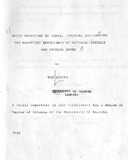| dc.description.abstract | This study attempts to determine differentials til mortality by socio-economic, demographic and household environmental factors by prevailing HIV regimes, taking recourse to estimate the HIV / AIDS incidence and prevalence as well as the impact of AIDS on the under five mortality by the prevailing HIV regimes. The broad research question that was to be answered was whether there exist marked socio-economic, demographic and household environmental factors by the prevailing HIV regimes. The study used sentinel surveillance data from the National AIDS/STDs Control Programme (NASCOP) and the
1989 population census from the central bureau of statistics (CBS). Analysis of under five mortality was done using Coale and Trussell version of the Brass method while for adult mortality orphanhood method was used. The impact of AIDS on under five mortality was done using Stover and others (1994) method.
The results show that generally those in high HIV regimes experienced the highest mortality followed by those in mid HIV regime. Those in low HIV regime experienced the lowest mortality in all the HIV regimes, differentials in under five mortality by household environmental and socio-economic factors, depicted consistent pattern whereby: children in households with modern toilet facility, modern t100r material type, clean drinking water and who reside in urban areas had generally lower risk of death when compared with their counterparts in worse off categories; higher levels of mothers education, good employment opportunities, female children, the unmarried or those mothers in monogamous marriage were also associated with lower risk of under five mortality.
The study also established that female adult experienced lower risk of death than male adults in all the HIV regimes. Although the general childhood pattern among various
IV
socio-economic groups and household environmental conditions remained unchanged with the introduction of HIV IAIDS in the impact model, childhood mortality rates increased substantially while the gaps between the better off and well off categories diminished. This suggests that the impact of AIDS on mortality is greater among the better off categories.
This study therefore recommends the following measures to facilitate significant reduction in the observed mortality levels and differentials: the improvement of the quality of the dwelling unit; provision of cheap affordable education to higher levels for females; creation of additional employment opportunity especially for females; and stepping up campaign against HIV IAIDS. The study also recommends that N ASCOP in collaboration with all stakeholders should sharpen and broaden the data collection instruments so as to facilitate in-depth analysis of HIV IAIDS and its impact. | en |

